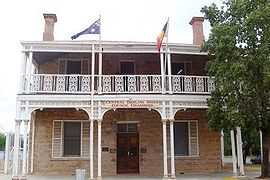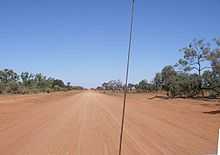Wilcannia
| Wilcannia New South Wales | |||||||
|---|---|---|---|---|---|---|---|
 Central Darling Council Chambers | |||||||
 Wilcannia | |||||||
| Coordinates | 31°34′S 143°22′E / 31.567°S 143.367°ECoordinates: 31°34′S 143°22′E / 31.567°S 143.367°E | ||||||
| Population | 604 (2011)[1] | ||||||
| Established | 1866 | ||||||
| Postcode(s) | 2836 | ||||||
| Elevation | 75.0 m (246 ft) | ||||||
| Location |
| ||||||
| LGA(s) | Central Darling Shire | ||||||
| County | Young County | ||||||
| State electorate(s) | Murray-Darling | ||||||
| Federal Division(s) | Parkes | ||||||
| |||||||
Wilcannia is a small town located within the Central Darling Shire in north western New South Wales, Australia. This was the third largest inland port in the country during the great river boat era of the mid-19th century.[2] At the 2011 census, Wilcannia had a population of 604.[1]
History
The name Wilcannia is said to be derived from an Aboriginal term for either 'gap in the bank where floodwaters escape' or 'wild dog'. Neither meaning has been linguistically verified.[2]
In 1835, explorer Major Thomas Mitchell was the first European to the region, in which he traced the Darling River to what is now Menindee.[3] In June 1866, the township of Wilcannia was proclaimed.[3] In 1871, the population was 264, and grew to 1,424 by 1881.[4] During the 1880s, Wilcannia reached its peak, and had a population of 3000 and 13 hotels and its own newspaper.[3]
Geography
Wilcannia is located where the Barrier Highway crosses the Darling River, 965 kilometres (600 mi) from Sydney. The environment is borderline semi-arid to desert with an annual rainfall of 255 millimetres (10.0 in). Wilcannia is located within the Darling Riverine Plains Bioregion (IBRA classification, Department of Environment), consisting of landscapes adapted to flooding. Common species include River Red Gum, Yellow Box, Oldman Saltbush and Lignum.
The surrounding area is very sparsely settled by pastoralists who have large land holdings, used primarily to run sheep. These holdings fall in the Western Division and the majority are held as 99-year leases.
Climate
Wilcannia has a semi-arid climate with hot summers and cool winters. Mean maximum daily temperature in summer is 34°C and in winter is 19°C. The highest temperature recorded in Wilcannia was 50.0 °C (122.0 °F) on 11 January 1939.[5] This was during the severe heatwave of January 1939.
| Climate data for Wilcannia (Reid Street) | |||||||||||||
|---|---|---|---|---|---|---|---|---|---|---|---|---|---|
| Month | Jan | Feb | Mar | Apr | May | Jun | Jul | Aug | Sep | Oct | Nov | Dec | Year |
| Record high °C (°F) | 48.2 (118.8) |
47.1 (116.8) |
44.4 (111.9) |
38.4 (101.1) |
31.3 (88.3) |
29.3 (84.7) |
30.6 (87.1) |
32.4 (90.3) |
39.4 (102.9) |
40.7 (105.3) |
45.2 (113.4) |
46.8 (116.2) |
48.2 (118.8) |
| Average high °C (°F) | 35.4 (95.7) |
34.6 (94.3) |
31.3 (88.3) |
26.2 (79.2) |
21.2 (70.2) |
17.7 (63.9) |
17.1 (62.8) |
19.5 (67.1) |
23.5 (74.3) |
27.4 (81.3) |
31.2 (88.2) |
33.9 (93) |
26.6 (79.9) |
| Average low °C (°F) | 19.8 (67.6) |
19.3 (66.7) |
16.2 (61.2) |
11.7 (53.1) |
7.9 (46.2) |
5.4 (41.7) |
4.2 (39.6) |
5.6 (42.1) |
8.4 (47.1) |
12.2 (54) |
15.6 (60.1) |
18.2 (64.8) |
12.0 (53.6) |
| Record low °C (°F) | 9.2 (48.6) |
8.8 (47.8) |
6.4 (43.5) |
1.8 (35.2) |
−2.5 (27.5) |
−2.8 (27) |
−5.0 (23) |
−3.3 (26.1) |
−0.5 (31.1) |
3.4 (38.1) |
3.9 (39) |
8.4 (47.1) |
−5.0 (23) |
| Rainfall mm (inches) | 25.9 (1.02) |
26.5 (1.043) |
24.7 (0.972) |
17.1 (0.673) |
23.6 (0.929) |
22.2 (0.874) |
18.4 (0.724) |
17.5 (0.689) |
15.9 (0.626) |
25.2 (0.992) |
20.9 (0.823) |
26.0 (1.024) |
263.9 (10.39) |
| Avg. precipitation days | 2.9 | 2.9 | 2.7 | 2.7 | 4.1 | 4.6 | 4.4 | 4.2 | 3.4 | 4.0 | 3.4 | 3.2 | 42.5 |
| Source: Bureau of Meteorology[6] | |||||||||||||
Significant Weather
On 9 November 1950, a severe thunderstorm with damaging winds and large hail the size of cricket balls struck the town. Two people were injured, dozens of homes lost their roofs and nearly every house in town was damaged due to the large hail.[7]
Demography
From the 2011 Census, Wilcannia had a population of 604 with 466 (77%) people being of Aboriginal descent. Wilcannia has 211 private dwellings.[1]
Gallery
-
from the bed of the Darling River
-
Street Scene
-
Street Scene
-
Abandoned building by the Darling River
-
Wilcannia Police Station with Melia azedarach
-
Abandoned Building
-
Residence near the Anglican Church
-
Bridges over the Darling River
-
Old Post Office
-
Old warehouse
-

The Bourke-Wilcannia road, near Bourke
References
- ↑ 1.0 1.1 1.2 "2011 Census QuickStats - Wilcannia (Urban Centre/ Locality)". Australian Bureau of Statistics. October 2012. Retrieved 25 March 2013.
- ↑ 2.0 2.1 "Wilcannia". Geographical Names Register (GNR) of NSW. Geographical Names Board of New South Wales. Retrieved 2009-07-24.
- ↑ 3.0 3.1 3.2 "Wilcannia - Culture and History". Fairfax Media. November 2008. Retrieved 25 March 2013.
- ↑ "NSW 1881 census page vii". Australian National University. Retrieved 25 March 2013.
- ↑ "Year Book Australia 2009–10". Australian Bureau of Statistics. p. 97. Retrieved 25 March 2013.
- ↑ "Wilcannia (Reid St)". Climate statistics for Australian locations. Bureau of Meteorology. Retrieved 25 March 2013.
- ↑ "Hurricane And Hail Storm Lashes Far-western Town.". The Sydney Morning Herald (NSW : 1842 - 1954) (NSW: National Library of Australia). 10 November 1950. p. 1. Retrieved 25 March 2013.
External links
![]() Media related to Wilcannia, New South Wales at Wikimedia Commons
Media related to Wilcannia, New South Wales at Wikimedia Commons
| |||||









